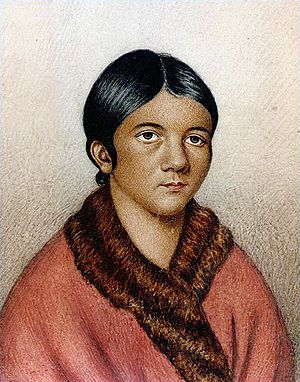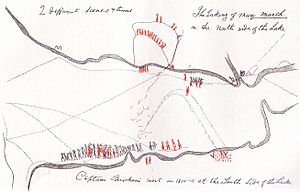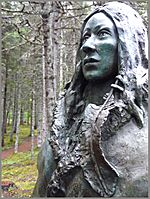Shanawdithit facts for kids
Quick facts for kids
Shanawdithit
|
|
|---|---|

A beothuk woman (ca. 1841) believed to be Shanawdithit, though possibly a reproduction of a portrait of Demasduit.
|
|
| Born |
Shanawdithit
ca. 1801 |
| Died | June 6, 1829 (aged 27–28) |
| Cause of death | Tuberculosis |
| Other names | Shawnadithit, Shawnawdithit, Nancy April |
| Known for | last Beothuk |
Shanawdithit (born around 1801 – died June 6, 1829) was the very last known person of the Beothuk people. The Beothuk lived on the island of Newfoundland, which is now part of Canada. Shanawdithit is remembered for helping us understand Beothuk culture. She made drawings that showed how her people interacted with European settlers. Shanawdithit passed away from a lung disease called tuberculosis in St. John's, Newfoundland, on June 6, 1829. She was also known by other names like Shawnadithit, Shawnawdithit, and Nancy April.
Contents
Shanawdithit's Early Life with the Beothuk People
Shanawdithit was born around 1801 near a large lake on the island of Newfoundland. At that time, the number of Beothuk people was getting smaller. Their traditional way of life was becoming harder to maintain. This was because European settlers were moving into their lands. Also, other Indigenous groups were expanding. The Beothuk people also faced new diseases from Europe, like smallpox. They had no natural protection against these illnesses. The Beothuks were also slowly being cut off from the sea, which was an important source of food for them.
Most Indigenous groups in the Americas at this time had some contact with European settlers. They often traded goods, which helped them survive. However, the Beothuks had mostly avoided contact with outsiders for a long time. Trappers and fur traders sometimes saw the Beothuks as thieves and would attack them. When Shanawdithit was a child, a white trapper shot her while she was washing venison (deer meat) in a river. She was hurt for a while but eventually got better.
In 1819, Shanawdithit's aunt, Demasduwit, was captured by a group of settlers. After this, the few remaining Beothuks fled. In the spring of 1823, Shanawdithit's father died after falling through ice. Most of her family had already passed away from hunger, sickness, cold weather, and attacks from European settlers. In April 1823, Shanawdithit, her mother (Doodebewshet), and her sister (whose Beothuk name is not known) met some trappers. They were looking for food in the Badger Bay area. William Cull and the three women were taken to St. John's. Sadly, Shanawdithit's mother and sister died there from tuberculosis.
Shanawdithit's Later Life in the Newfoundland Colony
The settlers in the Newfoundland Colony gave Shanawdithit a new name: "Nancy April." They named her after the month she was captured. She was taken to Exploits Island and worked as a servant in the Peyton family's home. There, she started to learn some English. The government hoped she could help them connect with her people. However, Shanawdithit refused to go with any expeditions. She said the Beothuks would harm anyone who had been with Europeans. She believed this was a way to make up for those who had been killed.
In September 1828, Shanawdithit moved to St. John's. She went to live with William Eppes Cormack. He was from Scotland and had started a group called the Beothuk Institution. Cormack was a businessman and a kind person. He wrote down many things Shanawdithit told him about her people. He also added notes to her drawings. Shanawdithit stayed with Cormack until early 1829 when he left Newfoundland.
After Cormack left, the attorney general, James Simms, took care of Shanawdithit. She spent the last nine months of her life at his home. She had been in poor health for several years. A doctor named William Carson looked after her. In 1829, Shanawdithit died in a St. John's hospital after her long struggle with tuberculosis. Her death was reported in a local newspaper and even in the London Times. The news articles mentioned that Shanawdithit was very talented. They also described the Beothuk as unique because they did not form strong relationships with European settlers or other Indigenous groups.
What Happened After Shanawdithit's Death
After Shanawdithit passed away, Dr. William Carson examined her body. He noticed some unusual features on her skull. He later sent her skull to the Royal College of Physicians in London for study. Shanawdithit was buried in the graveyard of St. Mary the Virgin Church in St. John's.
In 1938, the Royal College of Physicians gave her skull to the Royal College of Surgeons. Sadly, it was lost during the German bombing of London in World War II.
In 1903, the church graveyard itself was removed to make way for railway construction. The church building was torn down in 1963. Today, a monument stands at the site. It says: This monument marks the site of the Parish Church of St. Mary the Virgin during the period 1859–1963. Fishermen and sailors from many ports found a spiritual haven within its hallowed walls. Near this spot is the burying place of Nancy Shanawdithit, very probably the last of the Beothuks, who died on June 6, 1829.
Shanawdithit's Legacy
Shanawdithit was very important in helping us learn about the Beothuk people. Without her stories and drawings, we would know very little about them. A researcher named Ingeborg Marshall has explained that what we know about Beothuk history depends on who wrote it down. She points out that many European accounts saw native people as less important. Marshall notes that without Shanawdithit's own accounts, the Beothuk voice would be almost completely missing from history.
In 2000, Shanawdithit was recognized as a National Historic Person in Canada. This means she is considered a very important figure in Canadian history. At the same time, a statue of Shanawdithit was put up at the Beothuk Interpretation Centre near Boyd's Cove. The statue is called The Spirit of the Beothuk and was created by Gerald Squires. In 2007, a special plaque was placed in St. John's Bannerman Park to remember her life. It honors her contributions to the historical records of how the Beothuk and European settlers met. It also mentions the capture of her aunt, Demasduit.
Many people in Newfoundland know about Shanawdithit. In 1851, a local newspaper called her "a princess of Terra Nova." In 1999, readers of The Telegram newspaper voted her the most notable Aboriginal person of the past 1,000 years. She received 57% of the votes.
See also
- Notable Aboriginal people of Canada
- List of people of Newfoundland and Labrador
 In Spanish: Shanawdithit para niños
In Spanish: Shanawdithit para niños



